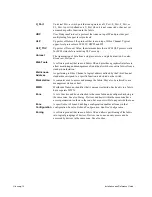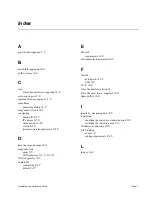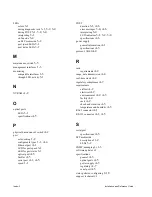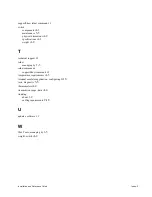
Installation and Reference Guide
Glossary-9
SI
Sequence Initiative.
Single Mode
The fiber optic cabling standard that corresponds to distances of up to 10 km
between devices.
SNMP
Simple Network Management Protocol. An internet management protocol that
uses either IP for network-level functions and UDP for transport-level functions,
or TCP/IP for both. Can be made available over other protocols, such as UDP/IP,
because it does not rely on the underlying communication protocols. See also
Community (SNMP).
SNS
Simple Name Server; a switch service that stores names, addresses, and attributes
for up to 15 minutes, and provides them as required to other devices in the fabric.
SNS is defined by Fibre Channel standards and exists at a well-known address.
May also be referred to as directory service. See also FS.
Switch
Hardware that routes frames according to Fibre Channel protocol and is
controlled by software.
Switch Name
The arbitrary name assigned to a switch.
Switch Port
A port on a switch. Switch ports can be E_Ports, F_Ports, or FL_Ports.
SWL
Short Wavelength; a type of fiber optic cabling that is based on 850mm lasers and
supports 1.0625 Gbps link speeds. May also refer to the type of GBIC or SFP. See
also LWL.
Target
A storage device on a Fibre Channel network. See also Initiator.
Tenancy
The time from when a port wins arbitration in a loop until the same port returns to
the monitoring state. Also referred to as loop tenancy.
Throughput
The rate of data flow achieved within a cable, link, or system. Usually measured
in bps (bits per second). See also Bandwidth.
Topology
As applies to Fibre Channel, the configuration of the Fibre Channel network and
the resulting communication paths allowed. There are three possible topologies:
•
Point to point - A direct link between two communication ports.
•
Switched fabric - Multiple N_Ports linked to a switch by F_Ports.
•
Arbitrated loop - Multiple NL_Ports connected in a loop.
Translative
Mode
A mode in which private devices can communicate with public devices across the
fabric.
Transmission
Character
A 10-bit character encoded according to the rules of the 8B/10B algorithm.
Transmission
Word
A group of four transmission characters.
Trap (SNMP)
The message sent by an SNMP agent to inform the SNMP management station of
a critical error. See also SNMP.
Trunking
See ISL Trunking.
Tunneling
A technique for enabling two networks to communicate when the source and
destination hosts are both on the same type of network, but are connected by a
different type of network.






































